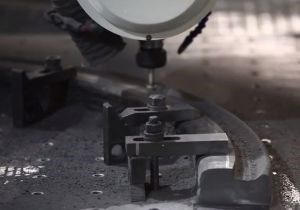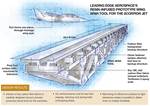Large-format CNC routing for large CFRP parts
5-axis CNC routers can provide fast, precision machining of increasingly larger parts, but also rapid payback.

High-speed machining has become a necessary function for carbon fiber reinforced plastic (CFRP) parts production. The video below shows the type of detailed, high-speed machining now common in the manufacture of CFRP parts for the aerospace industry.
“High-speed 5-axis CNC routers not only move the head at a high rate, but also the tool at high RPM, which is key for machining carbon fiber parts,” says David Steranko, VP of sales for Anderson America (Pineville, NC, US). “These machines have the ability to pay back the capital expense rapidly as well,” he notes. For example, in the past, fabricators bought large-format metal machining centers costing $4-5 million. “CNC routers were viewed as not precise enough,” says Steranko, “but advances over the past decade have enabled the precision and even higher speed, without the cost.” He notes these large-part capable, high-speed 5-axis CNC routers cost $500,000 to $900,000.
Steranko says the shape, thickness and size of parts being demanded today typically won’t fit standard 5-axis CNC routers. “The challenge for us is to have bigger, faster machines but maintain high precision.” He says this has indeed been mastered, as can be seen in the video, and these machines can also machine multiple parts at the same time. “One customer is using twin tables so that the machine runs 24 hrs/day, 7 days/week,” says Steranko. “This is two to three times the performance of old machining centers.”
For those not as involved in the machining end of composites operations, here is a primer from our sister magazine, Modern Machine Shop:
Five-Axis Machining Centers do not just move in the linear axes X, Y and Z. Instead, these machines also move in two rotary axes, often identified as A and B. The rotary axes tilt the tool with respect to the part. Physically, it can be either the tool that tilts or the part that tilts. Different machines accomplish the rotary motion in different ways. Some machines move the rotary axes only to position the tool or work outside of the cut. This is referred to as 3+2 machining. Moving the tool in this way dramatically increases the machining center’s access to features at different angles or on different faces of the part. A machine capable of 3+2 machining often can reach all of the machined features of the part in a single setup. True five-axis machining refers to the ability to not just position the tool along the rotary axes, but also to feed the tool through the cut using these axes. Interpolated combinations of A-axis, B-axis and linear axis motions can allow the tool to smoothly follow a contoured surface. This type of machining has long been important in the aerospace industry, where machined parts follow the aerodynamic forms of aircraft.
Related Content
-
Plant tour: Joby Aviation, Marina, Calif., U.S.
As the advanced air mobility market begins to take shape, market leader Joby Aviation works to industrialize composites manufacturing for its first-generation, composites-intensive, all-electric air taxi.
-
The lessons behind OceanGate
Carbon fiber composites faced much criticism in the wake of the OceanGate submersible accident. CW’s publisher Jeff Sloan explains that it’s not that simple.
-
Combining multifunctional thermoplastic composites, additive manufacturing for next-gen airframe structures
The DOMMINIO project combines AFP with 3D printed gyroid cores, embedded SHM sensors and smart materials for induction-driven disassembly of parts at end of life.














.jpg;maxWidth=300;quality=90)
